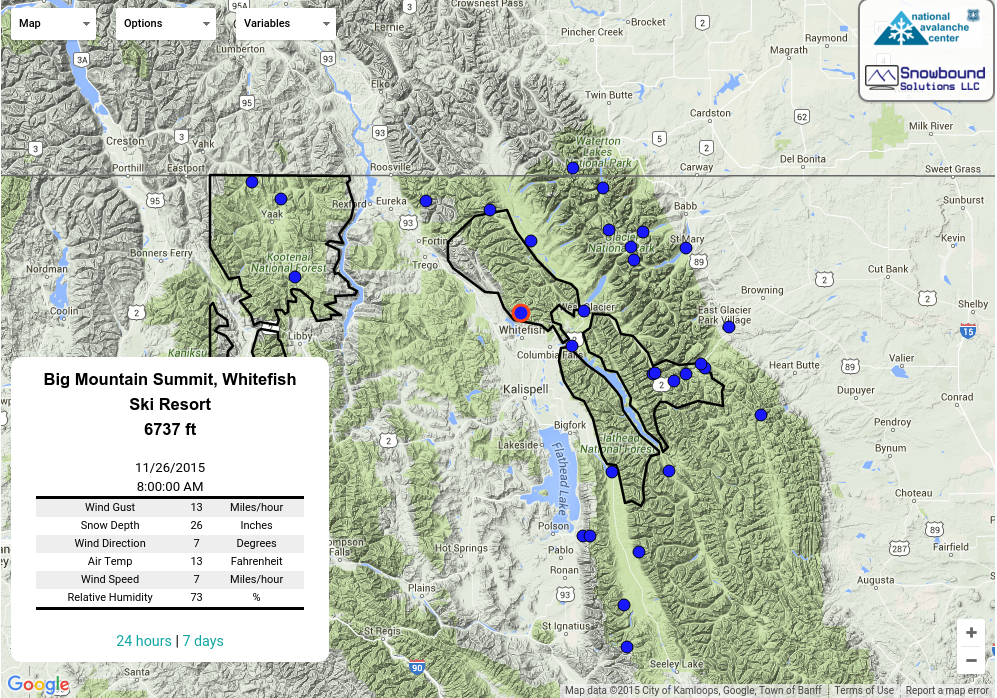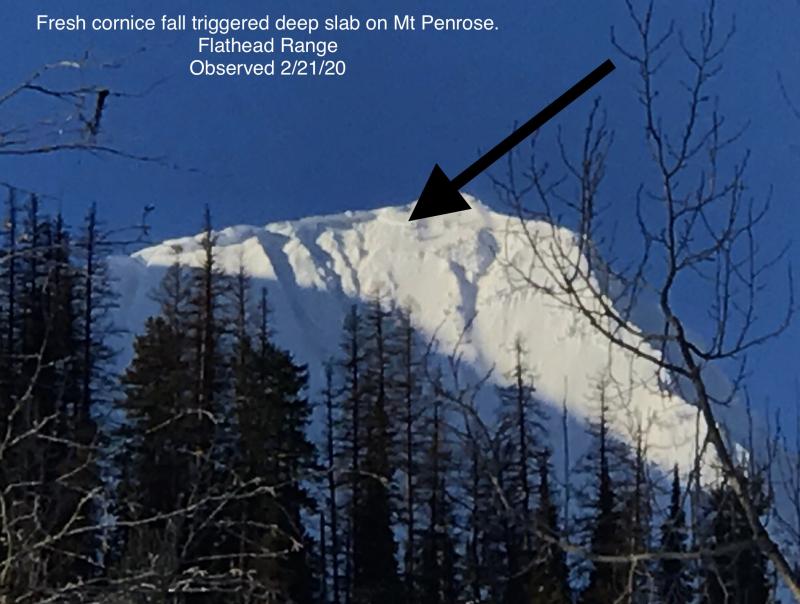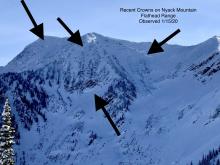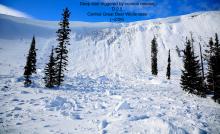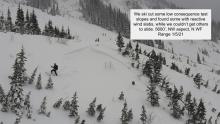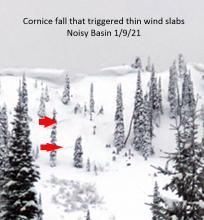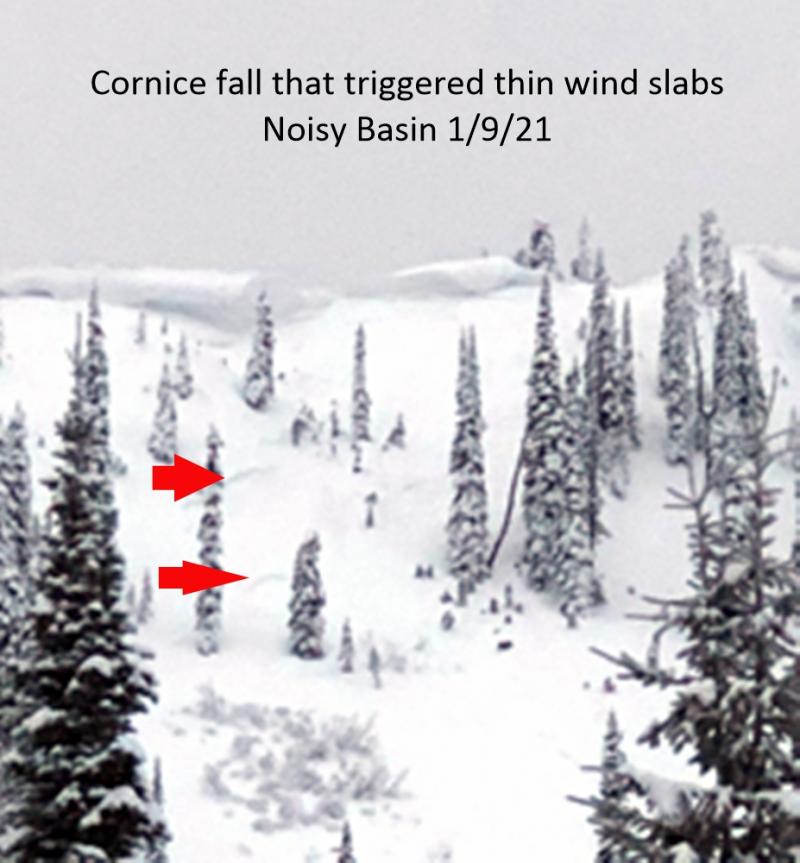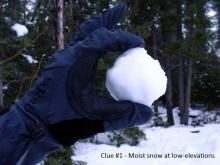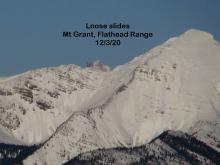| Thursday | Thursday Night | Friday | |
|---|---|---|---|
| Cloud Cover: | Partly Cloudy | Partly Cloudy | Mostly Cloudy |
| Temperatures: | 36 to 41 deg. F. | 25 to 30 deg. F. | 34 to 39 deg. F. |
| Wind Direction: | Southwest | Southwest | Southwest |
| Wind Speed: | 5 to 15, G25 | 5 to 15, G25 | 5 to 15, G25 |
| Snowfall: | 0" in. | 0" in. | 0 to 1" in. |
| Snow Line: | 2500' | 4500' | 4500' |
Flathead Range and Glacier National Park
How to read the forecast
Unusually warm weather will increase the chances of large cornice falls, and hard wind slabs linger in alpine terrain. Reduce your exposure below cornices as the day warms up; they can trigger slab avalanches below. If you see active rollerballs or pinwheels, move to colder snow for safer, higher quality riding.

2. Moderate
?
Above 6500 ft.
1. Low
?
5000-6500 ft.
1. Low
?
3500-5000 ft.
- 1. Low
- 2. Moderate
- 3. Considerable
- 4. High
- 5. Extreme
-
Type ?
-
Aspect/Elevation ?
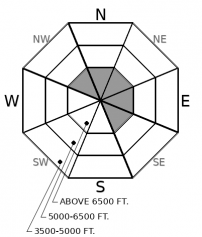
-
Likelihood ?CertainVery LikelyLikelyPossible
 Unlikely
Unlikely -
Size ?HistoricVery LargeLargeSmall

Large cornice falls are possible as temperatures rise today. In the past few weeks, a few cornice falls have triggered large, deep slabs (Example A, Example B). These slides are good reminders of the lingering danger of very large avalanches breaking on weak snow near the ground in high alpine bowls and on steep faces in the Flathead Range and Glacier National Park. Cornice fall is the most likely trigger for these unsurvivable avalanches. Even though deep slab avalanches are rare, it’s good policy to limit your time under steep northerly and easterly start zones, especially with today's notable warming.
-
Type ?
-
Aspect/Elevation ?

-
Likelihood ?CertainVery LikelyLikelyPossible
 Unlikely
Unlikely -
Size ?HistoricVery LargeLargeSmall

Yesterday's raging winds left hard slabs of drifted snow scattered around leeward slopes. Observers yesterday reported most of the wind loading was occurring onto alpine bowls and faces in the Flathead and Glacier Park, although expect to find a few dense drifts near mid-elevation ridgelines or crossloaded gullies. Slabs will be difficult to trigger, yet they are thick and dense enough to break above you. In steep terrain, steer away from rounded dunes where the snow looks and feels denser, thicker, and harder.
-
Type ?
-
Aspect/Elevation ?

-
Likelihood ?CertainVery LikelyLikelyPossible
 Unlikely
Unlikely -
Size ?HistoricVery LargeLargeSmall

The snow surface will get wet today with warm temperatures. In isolated areas, the snow surface may become unstable and produce shallow loose wet avalanches. These wet goobers can plow you off your feet and drag you into a tree or push you over a rock band. Pay attention to the snow surface. If the snow starts to rollerball, pinwheel, or produce natural sluffs, seek out colder snow or lower angle terrain to avoid the problem.
Yesterday’s headline was wind. Today’s headline is warm. Both have left us with a unique set of problems.
The Wind: Southwesterly winds were blasting up to 80 mph yesterday. For better or worse, the forecasted snowfall didn’t come to fruition, which limited snow available for transport. The most active wind loading yesterday was at the highest elevations: namely the peaks of the Flathead Range and Glacier Park. The resulting wind slabs are the type I don’t like to mess with: hard, dense, and unpredictable. They won’t be easy to trigger, but they also won’t be easy to escape from either. While the problem is most pronounced at high elevations in the Park and Flathead Range, you might find a few smaller wind slabs lurking elsewhere.
The Warm: Another springlike day is in store. Warm, lots of sunshine. Yep, you've heard it before - this isn’t the first warmup and our snowpack can handle it. The biggest concern is the continued threat of cornice falls, and in isolated areas of the Flathead and Park, the potential for a larger deep slab or wind slab release. A lack of recent snowfall and yesterday’s wind blast have left us with a mix of crusty or wind hardened surfaces. We don’t expect these surfaces to react dramatically to today’s warmup. Soft snow that warms up will be most reactive; this could happen on sheltered northerly aspects if we get enough cloud cover for greenhousing. If surfaces crusts thaw into slushy snow on south aspects, this can also produce loose wet avalanches. Monitor the snow surface and you can easily manage this problem.
A high pressure ridge is moving overhead today, bringing another beautiful, yet unseasonably warm, spring-like day. We are expecting thin, high clouds, light winds, and mountain temperatures to rise towards 40 degrees. The sunny weather is shortlived, tomorrow brings more clouds with a chance for rain and snow showers. Saturday's cold front looks like our best chance at accumulating snowfall.
This forecast applies only to backcountry areas outside established ski area boundaries. The forecast describes general avalanche conditions and local variations always occur. This forecast expires at midnight on the posted day unless otherwise noted. The information in this forecast is provided by the USDA Forest Service who is solely responsible for its content.

